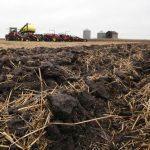PAYNTON, Sask. – In the late 1990s, Laurence Pellizzari was using a 39.5-foot Flexi-Coil 5000 air drill on 7.2-inch spacing to seed his farm near Paynton, Sask.
At the time, he was banding nitrogen in the fall and seeding in the spring. Add a spring harrow pass or two to prepare his canola fields and these trips made him think about his seeding operation.
With the original system, Pellizzari could apply only a certain amount of fertilizer with the seed and had to make an initial pass over the field to apply the nitrogen. Because the drill openers were on a fairly narrow spacing, he tried mid-row banding and paired row seeding.
Read Also

VIDEO: Green Lightning and Nytro Ag win sustainability innovation award
Nytro Ag Corp and Green Lightning recieved an innovation award at Ag in Motion 2025 for the Green Lightning Nitrogen Machine, which converts atmospheric nitrogen into a plant-usable form.
In the fall of 2000, he switched openers on his drill to include one anhydrous opener between every two seed openers. This pattern of seed-anhydrous-seed, seed-anhydrous-seed meant that dry phosphorus, potassium and sulfur could be placed with the seed and any rate of nitrogen could be placed in a row between each paired row.
With one-inch seed openers and 3/4-inch anhydrous openers, the anhydrous band would be well away from the seed and eliminate seedling damage.
“The initial reason I thought of going with paired row is to accommodate whatever rate of nitrogen you want to apply,” he said.
“It’s like a mid-row band plus a paired row system, and that enables you to use whatever rate you want of anhydrous, without any consideration of damage to the seed.”
He said the paired row has advantages, even in wet years.
“You have a little more aeration going on, less disease in the canopy. I think you have to seed heavy enough not to allow so much tillering and that would allow for bigger heads. There may also be an advantage having a moisture and nutrient sink between two rows of seed. I don’t think I lost any yield to it.”
Pellizzari used a tow-behind cart for seed and fertilizer, with an ammonia tank on the back, to seed peas, canola, barley and wheat. With peas, he disconnected the ammonia and seeded peas on every row.
Even with a 14-inch space between each paired row, he said weeds between the paired rows weren’t an issue as long as he sprayed.
“The only con with the paired row system was canopy closure in wheat. With barley, canola and peas, it wasn’t really an issue. But we had two years of really bad drought and I felt it wasn’t the best system for when it’s really dry.”
After some dry years, Pellizzari converted the drill to a regular nine-inch spacing direct seeder.
“The way it was before, there was no change in the original 7.2-inch spacing. I just had an anhydrous knife every third run and the headers for the anhydrous. To go to the nine-inch spacing, I had to purchase a kit from Flexi-Coil that involved packer spacers and four gang shafts. They have schematics for 7.2-inch, nine-inch and 12-inch spacing and you follow along with that. According to the schematic, all the shanks had positions so many inches from certain points, so you can position them not too badly.”
He removed 13 of the original 65 openers on the drill. The rest were loosened, repositioned and retightened.
“There are a couple of positions you have to use offset shanks Ð there’s four of them in different areas Ð but it’s not a big problem. It was mostly a case of moving some and removing others. The hardest part was definitely taking the packers apart.”
Each packer gang was removed from the drill, taken apart and reassembled with different spacers on the shaft between each packer to ensure the packers followed behind the openers. They were rusty and he had to heat some of them as well as cut off all the bearings.
Pellizzari has 2.5-inch wide packers on a nine-inch spacing machine instead of the 3.5-inch packers typically found on those machines, “which is fine for me because I’m using a narrow knife, so there’s no problem. I don’t use a spread tip of any kind, so they fit the furrow nicely.”
Pellizzari used two knives on the drill this year: upright Atom Jets and Bourgault knives that slope backward. He expects he’ll go with all Atom Jets next year.
“The soil flows around a lot neater. It throws less soil and when you do that, you have less disturbance. I think all the companies are going to go to a more vertical knife.”
He now pulls a liquid cart instead of an anhydrous tank behind the seed cart and fertilizer is applied as liquid with the Atom Jet opener.
“It does cost a little more for the N Ð maybe two or three cents Ð but I’m not using high rates of nitrogen any more in this area. The reason I went to the liquid is because of the cost of nitrogen. It’s probably the most efficient way of side banding. You get the most use out of what you’re doing there,” he said.
“With liquid, you can get a little closer to the seed with a sideband than any dry or anhydrous. That’s one of the main reasons I’m using liquid. I think in other areas, where you get a lot of rainfall, mid-row banding is a good option as well. You can put on 100 pounds of nitrogen and not worry about anything.”















